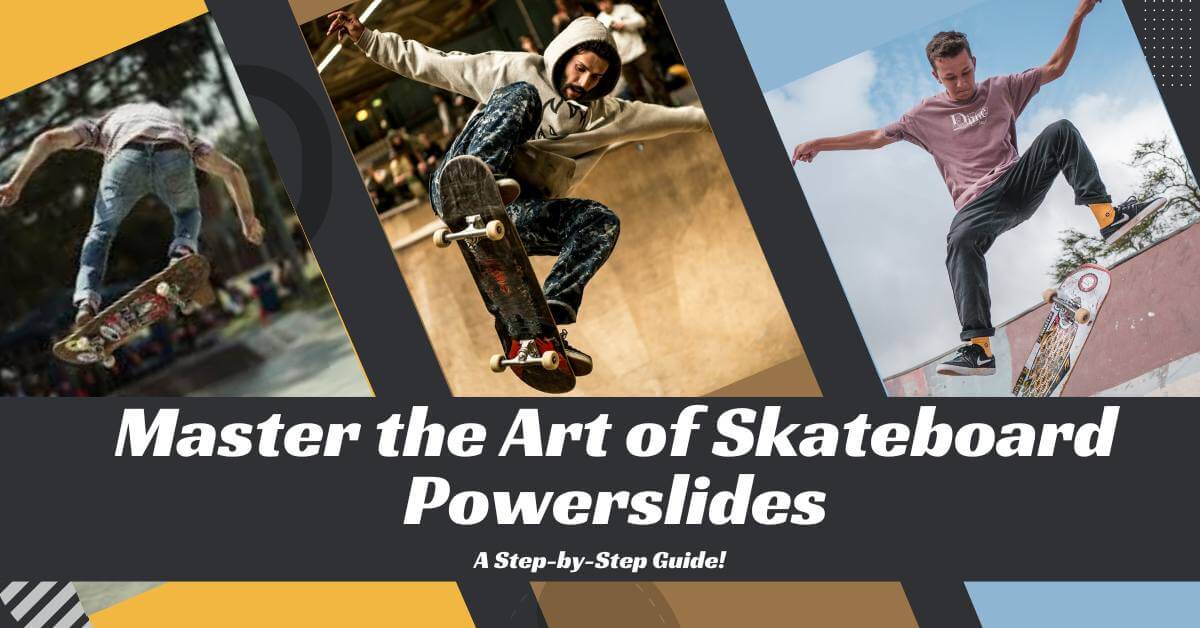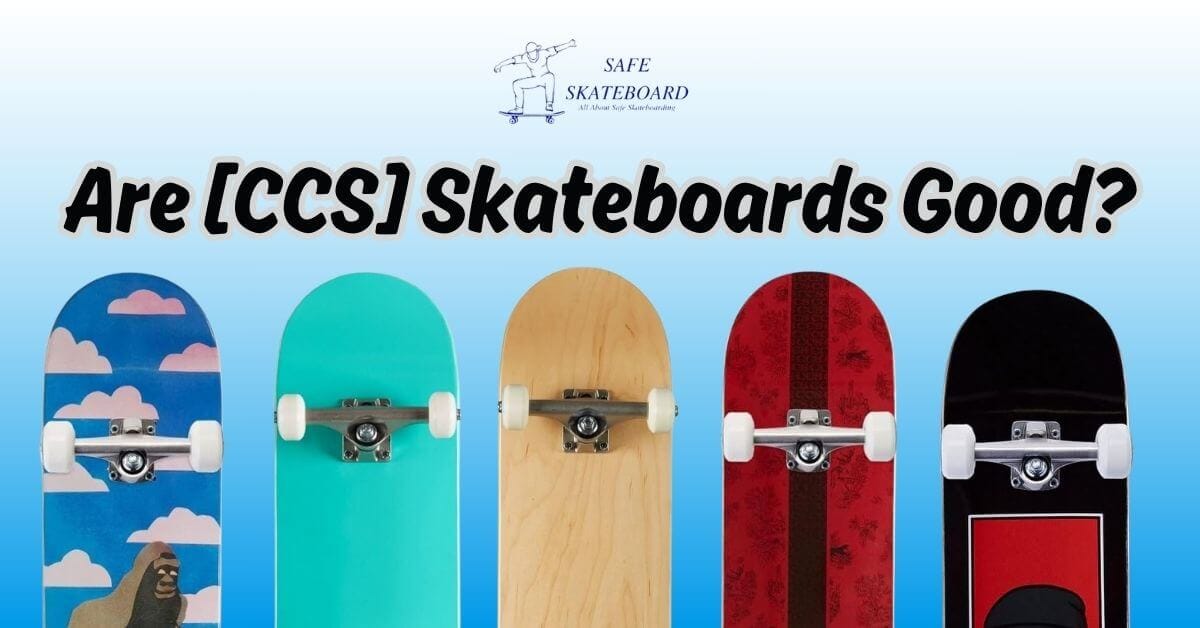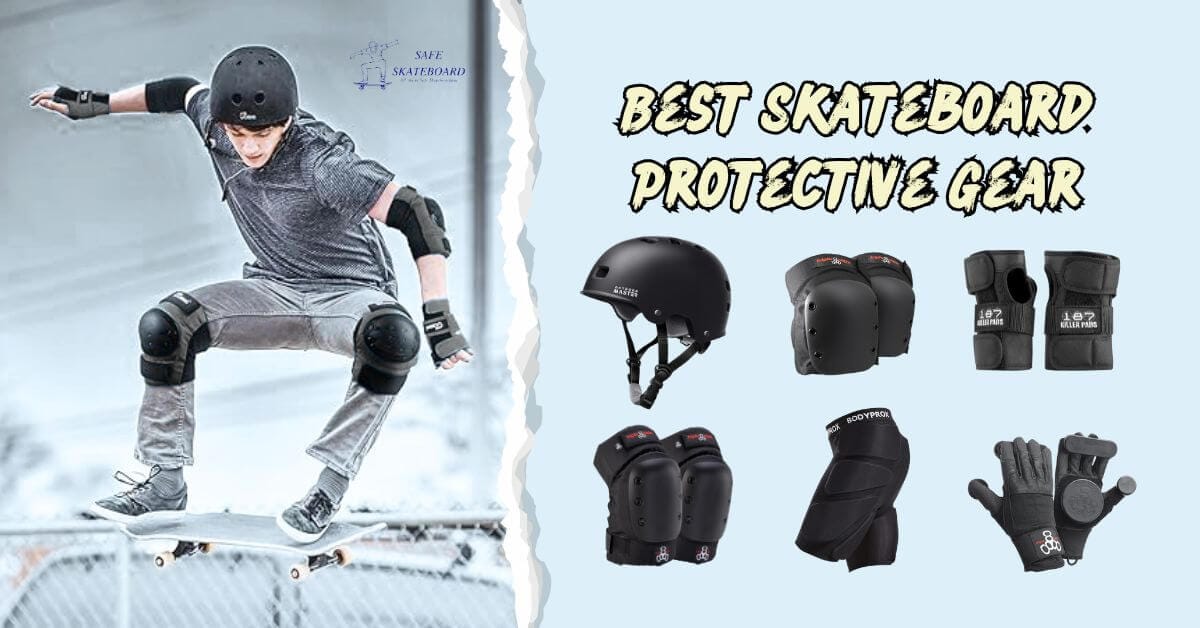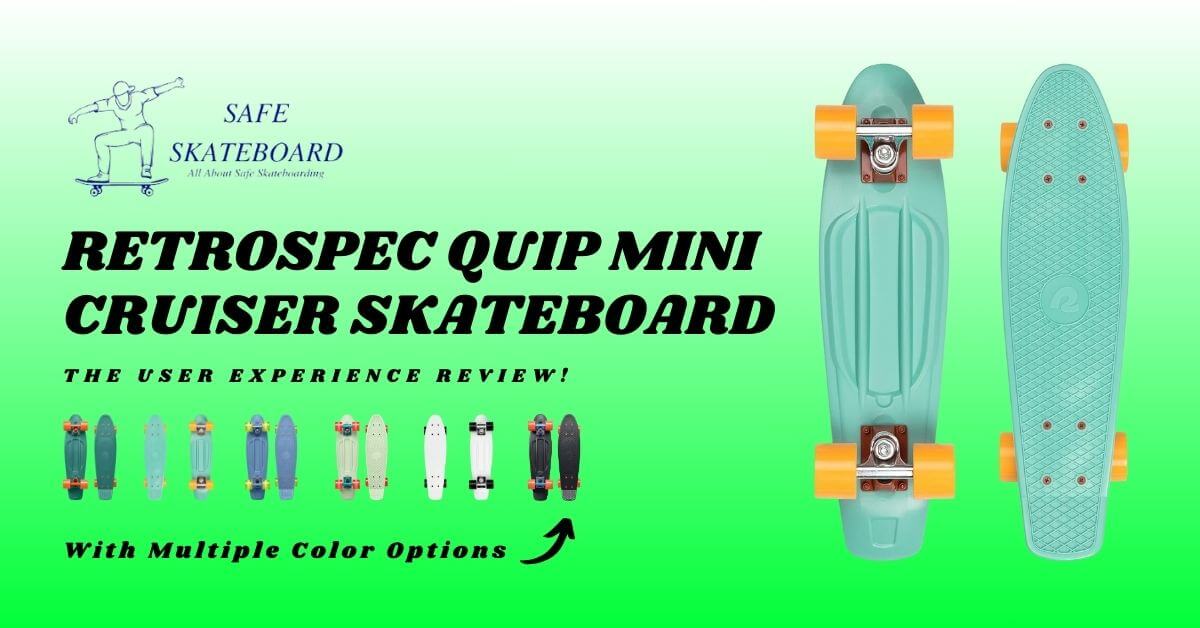Skateboarding is all about mastering cool tricks, and one of the essential skills every skater should learn is powerslide. If you’re looking to slow down or add style to your ride, the powerslide is a must-have move in your repertoire. But the question is: How To Powerslide On A Skateboard?
In this blog post, I’ll explore how to powerslide on a skateboard, backed by factual data and proven techniques.
Get ready to take your skateboarding skills to the next level and impress everyone at the local skatepark. Let’s dive in!
Understanding Skateboard Powerslides
Skateboarding requires various skills and tricks, and one of the most impressive and essential maneuvers to master is the powerslide. Whether you want to show off your skills to friends or gain better control over your skateboard, mastering the powerslide is necessary.
In this section, I will delve into the definition and purpose of skateboard powerslides and the benefits of mastering this skill.
Purpose Of Skateboard Powerslides
Skateboard powerslides involve intentionally sliding the wheels of your skateboard in a controlled manner, creating a sideways drift while maintaining control.
This maneuver can be executed by applying pressure to the tail or using your body weight to initiate the slide. Powerslides serve multiple purposes, including:
- Controlled deceleration: Powerslides allow you to quickly slow down or come to a complete stop, adding an extra layer of safety when approaching obstacles or navigating crowded areas.
- Directional control: Initiating a slide can change your direction without losing momentum. This can be particularly useful when executing tricks or navigating tight corners.
- Style and expression: Powerslides are not only functional but also aesthetically pleasing. Incorporating powerslides into your skateboarding repertoire allows you to showcase your unique style and creativity.
Mastering the powerslide technique brings many benefits beyond its visual appeal. Let’s explore what makes this skill worth pursuing.

Benefits Of Mastering Skateboard Powerslides
- Enhanced board control: You will better understand weight distribution and balance by learning to control your skateboard during a powerslide. This translates to improved control in various situations on the board.
- Increased confidence: Successfully executing powerslides boosts confidence and provides a sense of accomplishment. This confidence can extend to other skateboarding maneuvers, encouraging you to push your limits further.
- Versatility in skateboarding: Powerslides are applicable in different skateboarding disciplines, such as street, park, and downhill. Mastering this skill broadens your repertoire and allows you to adapt to different environments quickly.
- Advanced trick possibilities: Powerslides are a foundation for more advanced tricks and maneuvers, including slides, grinds, and spins. By first mastering the powerslide, you lay the groundwork for tackling more complex tricks.
Powerslides offers a unique combination of function, style, and skill development. With the ability to control your speed, change direction, and express your individuality, this maneuver is a valuable addition to any skateboarder’s arsenal.
Essential Skills For Skateboard Powerslides
Learn the essential skills for executing perfect skateboard powerslides with this comprehensive guide. Discover the techniques and tips needed to master the art of power sliding on a skateboard.
Powersliding on a skateboard is an impressive skill that looks cool and adds a touch of style to your overall skateboarding game. Mastering the art of powerslides requires a combination of proper foot placement, balance, and skateboard weight distribution, as well as body positioning and movements.

In this section, I will explore these essential skills in detail to help you perfect your slides.
01. Proper Foot Placement
- Position your front foot at a slight angle, facing toward the nose of the skateboard.
- Place your back foot on the skateboard’s tail, perpendicular to the board.
- Ensure both feet are firmly positioned on the board, with the balls of your feet providing the necessary grip.
02. Balance and Weight Distribution
- Maintain a centered stance with your weight evenly distributed between both feet.
- For a powerslide, slightly shift your weight towards the back foot while keeping enough pressure on the front foot to maintain control.
- Find the sweet spot where you have enough control but can still initiate and control the slide.
03. Body Positioning and Movements:
- Engage your core muscles to help you maintain stability and control throughout the slide.
- Start by crouching low, bending your knees, and lowering your center of gravity.
- As you approach the slide, lean back slightly, keeping your shoulders parallel to the board.
- Initiate the slide by pushing your back foot out, causing the wheels to break traction and slide sideways.
- Use your arms to help with balance and to generate momentum for the slide.
Remember, mastering slides takes practice, so be prepared for a few falls and keep pushing yourself to improve.
With time and dedication, you’ll soon be effortlessly executing stylish and controlled powerslides on your skateboard.
Choosing The Right Skateboard Setup
Learn how to powerslide on a skateboard with the proper setup. Discover the techniques and tips to execute the perfect powerslide and enhance your skateboarding skills.
Skateboarding is about cruising around and mastering cool tricks like the powerslide. The powerslide is a stylish move that requires a combination of technique, skill, and the proper skateboard setup. Here, I will focus on choosing the proper skateboard setup for powerslides.

01. Selecting the Right Wheels for Powerslides
- Durometer: Opt for skateboard wheels with a durometer between 78A and 87A. Softer wheels provide better grip, allowing you to control your slides effectively.
- Size: Consider a larger wheel diameter (54–60 mm), as it helps maintain momentum during slides.
- Contact Patch: Look for wheels with a wider contact patch, as it increases surface area and enhances slide control.
02. Adjusting Trucks for Optimal Control
- Loosen your skateboard trucks: Looser trucks provide excellent maneuverability, allowing you to initiate and maintain power slides more effortlessly. However, ensure they are not too loose, as it can affect stability.
- Fine-tune bushings: Clean skateboard bushings offer better responsiveness, allowing you to turn and slide smoothly. Experiment with different durometers and find the perfect balance for your riding style.
03. Skateboard Maintenance Tips
- Regularly clean your wheels: Dust, dirt, and debris can affect slide performance. Use a damp cloth to clean your wheels and ensure they are obstacles-free.
- Check your bearings: Smooth-rolling bearings are essential for executing smooth slides. Regularly clean bearings and lubricate them to ensure optimal performance.
- Monitor board condition: Powerslides can wear down your board over time. Check for cracks, delamination, or any signs of damage, and replace it if necessary.
Remember, choosing the correct skateboard setup tailored to your preferences is the key to perfecting your powerslide. Experiment, fine-tune, and practice consistently. With the proper setup and determination, you’ll be sliding with style quickly!
Preparing For The Powerslide on a Skateboard
Learn how to prepare for the powerslide on a skateboard with these essential tips and techniques. This skill requires practice, balance, and confidence to execute smooth and controlled slides. Get ready to take your skateboarding to the next level!
Powersliding on a skateboard is a stylish and impressive move every skateboard enthusiast aspires to perfect. While it may seem daunting initially, with the proper preparation and practice, anyone can learn to powerslide like a pro. So, before you don your helmet and hit the pavement, let’s go through the essential steps to prepare for this thrilling maneuver.

01. Warming Up and Stretching
- Engage in a light warm-up routine of jogging or jumping jacks to elevate your heart rate and increase blood flow to your muscles.
- Perform dynamic stretches that target the major muscle groups used in skateboarding, such as leg swings, arm circles, and torso twists.
- Focus on stretching your quadriceps, hamstrings, calves, and ankles to improve flexibility and prevent muscle strains during the powerslide.
- Spend a few minutes practicing balance exercises like standing on one leg or doing small hops to activate your stabilizing muscles.
02. Finding a suitable location to practice
- Seek out a spacious, flat area with a smooth surface, preferably free from traffic and pedestrians. Skate parks or empty parking lots are often ideal for practicing powerslides.
- Ensure that the ground is dry and free from debris or gravel, as these can impede your slide and make it more challenging to maintain control.
- Avoid uneven surfaces or surfaces with loose dirt, as they can cause your wheels to slip, leading to potential accidents.
03. Safety Equipment and Precautions for Powersliding
- Always wear protective gear when Skateboarding. For instance, a helmet, Elbow Pads, knee pads, and wrist guards to protect yourself from potential injuries.
- Invest in sturdy skate shoes with good traction to enhance your grip on the board while sliding.
- Consider wearing slide gloves, which can provide extra stability and protection for your hands during the power slide.
- Before attempting the powerslide, ensure that your skateboard is in good condition, with tight trucks and properly inflated wheels.
- Familiarize yourself with proper falling techniques to minimize the risk of injury if you lose control during the slide.
Following these essential preparation steps and taking necessary safety precautions will prepare you to embark on your powersliding journey. So, gear up, find a suitable practice spot, and prepare to slide with style and confidence!
Proper Technique For Skateboard Powerslides
Looking to master the proper technique for skateboard powerslides? Check out these helpful tips on powerslide on a skateboard like a pro. Perfect your technique and add an impressive move to your skateboarding skills.
Powersliding on a skateboard is a thrilling maneuver that can add style and flair to your skateboarding repertoire. Proper technique is essential to execute this move smoothly and with control.
In this section, I will delve into how to perform skateboard powerslides, covering the three key aspects: initiating the slide, controlling speed and direction, and stopping and regaining balance.
Initiating The Slide
- Position your feet: Place your front foot diagonally across the skateboard, with your toes pointing towards the corner of the nose. Your back foot should be parallel to the tail, near the edge.
- Bend your knees and prepare: Lower your center of gravity by bending your knees. This will provide stability and allow for better control during the slide.
- Shift your weight: As you approach the desired slide, shift your weight towards your back foot. This will transfer pressure onto the skateboard’s tail, initiating the slide.
- Twist your shoulders: Rotate your shoulders in the direction you want to slide. This movement will help to initiate and maintain the slide as you execute the maneuver.
- Apply pressure and lean: Apply pressure to the tail with your back foot and lean slightly back. This combination will create friction between the skateboard wheels and the pavement, resulting in a slide.
Controlling Speed and Direction
- Adjust your weight distribution: To control your speed, adjust the pressure you apply to the skateboard’s tail. More pressure will slow you down, while less pressure will allow you to maintain or increase speed.
- Use your shoulders: By shifting and rotating your shoulders, you can guide the direction of your powerslide. This movement influences the position of your body and board, enabling you to control the slide’s trajectory.
- Tweak your foot positioning: Small adjustments in foot placement can significantly impact your slide—experiment with angling your front foot slightly more or less to modify the slide’s direction.
- Practice board control: As you gain confidence with powerslides, focus on refining your control. This will help you maintain balance, stay centered over the board, and execute controlled slides.
Stopping And Regaining Balance
- Gradually release pressure: To come out of the slide and regain balance, gradually release the pressure on the tail. This will reduce friction and allow the wheels to regain traction.
- Realign your feet: As you exit the slide, reposition your feet to their regular skateboarding stance. This adjustment will optimize your balance and stability.
- Bend your knees: During and after the slide, maintain a slight bend in your knees. This position facilitates balance and control, enabling you to transition back into your regular skateboarding routine smoothly.
- Keep practicing: Mastering powerslides takes time and practice. The more you practice, the more comfortable you become with the technique, allowing you to execute fluid and controlled powerslides.
By following these guidelines for initiating the slide, controlling speed and direction, and stopping and regaining balance, you will be well on your way to mastering the art of skateboard powerslides. So, get out there, practice, and enjoy the exhilarating thrill of executing these impressive maneuvers on your skateboard.
Common Mistakes And How To Avoid Them
Learn how to powerslide on a skateboard without making common mistakes. Discover the techniques and tips to execute this daring maneuver and avoid unnecessary falls smoothly.

01. Here are some tips to help you avoid overcommitting or not committing
- Practice on a smooth surface with plenty of space to minimize the risk of injury.
- Start by initiating a slide at a moderate speed, gradually increasing your speed as you become more comfortable.
- Focus on maintaining a balanced and relaxed body position. Keep your weight centered over the skateboard.
- Use your arms and upper body to help control your balance and direction during the slide.
02. Some tips to help you avoid problems with foot positioning and weight distribution
- Stand with your feet positioned shoulder-width apart on the skateboard, with your toes slightly angled towards the board’s edge.
- Distribute your weight evenly between your front and back feet. Avoid leaning too far forward or backward, which can disrupt your balance.
- Transfer more weight to your back foot when initiating the slide while lifting the front foot slightly. This will help create the necessary friction to initiate the slide.
- Once the slide is initiated, adjust your foot positioning to maintain balance and control.
03. Here are some common challenges and tips to help you overcome them
- Controlling the speed and duration of the slide: Practice adjusting the amount of pressure on your back foot to control the slide. Gradually increase or decrease the pressure to achieve the desired speed and duration.
- Spinning out of control: To maintain control during a powerslide, focus on keeping your body and arms aligned with the direction of the slide. This will help prevent excessive spinning and maintain stability.
- Regaining balance after the slide: After completing a powerslide, it’s essential to quickly shift your weight back to the center of the skateboard to regain balance. Practice maintaining control and stability during the recovery phase.
Remember, mastering powerslides on a skateboard takes practice and patience.
Progressing To More Difficult Variations
Learn how to progress to more difficult variations and master the art of power sliding on a skateboard. With these expert tips, you’ll slide and glide like a pro.
01. Performing Powerslides on Different Surfaces
- On smooth concrete: Powerslides are more accessible on smooth concrete surfaces since there’s less resistance. You’ll need to focus on shifting your weight and using your body and arms to control the slide.
- On rough or uneven surfaces: Powerslides on rough or uneven surfaces can be more challenging. To maintain control, you must be prepared for the skateboard to bounce and adjust your body movements accordingly.
- On slippery surfaces: Power-sliding on slippery surfaces, such as wet pavement, can be risky. It’s essential to be cautious and take into account the reduced traction. Use lighter pressure and anticipate any potential loss of control.
02. Incorporating Powerslides into Tricks and Maneuvers
- Powerslide into a 180-degree turn: Begin by performing a powerslide, and as you reach the desired angle, use your body and arms to pivot the skateboard for a stylish 180-degree turn.
- Powerslides to set up for a trick: Powerslides can be used to set up for various tricks, such as kickflips or ollies. You can adjust your positioning and gain momentum for your next move by performing a controlled powerslide.
- Powerslide during a manual or a grind: Adding a powerslide before or during a manual or a grind can add flair to your tricks. Practice combining different moves and transitions smoothly for a more impressive performance.
Exploring Different Styles and Techniques:
- Switch powerslides: Challenge yourself by performing powerslides while riding in the switch (opposite) stance. This can help improve your overall skateboard control and expand your skill set.
- No-comply slides: Experiment with a no-comply setup, where you remove your front foot before initiating the slide. This gives your slides a distinct and stylish look.
- Powerslides with grabs: Combine powerslides with grabs like a melon or tail grab for a more technical and visually appealing trick. This adds complexity and showcases your ability to maintain balance and control.
Remember, progressing to more complex variations of power-sliding requires practice, patience, and a willingness to push your limits. Stay safe, wear protective gear, and refine your techniques to master these exciting variations.
Building Confidence And Consistency
Skateboarding is all about skill, style, and the ability to perform impressive tricks. One such trick that every skateboarder aspires to master is the powerslide. This exhilarating move involves sliding on the skateboard while maintaining control and balance. Building confidence and consistency is crucial when learning to power slide on a skateboard.
By practicing regularly, setting goals, visualizing success, overcoming fear, seeking feedback, and learning from mistakes, you’ll be well on your way to becoming a powerslide pro. Let’s dive deeper into these strategies:

Practicing Regularly And Setting Goals
- Dedicate regular practice sessions to honing your power slide technique.
- Start by focusing on the basics, improving your balance and board control.
- Set measurable goals, such as performing several successful slides in a session.
- Gradually increase the difficulty level by trying surfaces like smooth concrete or ramps.
- Challenge yourself by attempting powerslides at higher speeds or incorporating variations, like 180-degree spins.
Visualizing Success and Overcoming Fear
- Use the power of visualization to rehearse the perfect powerslide mentally.
- Imagine yourself confidently sliding on the skateboard, feeling the smoothness and control.
- Visualize conquering any fears or doubts, replacing them with confidence and excitement.
- Remember that fear is natural but can be overcome through consistent practice and believing in your abilities.
- Focus on the thrill and satisfaction you’ll experience once you conquer the powerslide.
Seeking Feedback and Learning From Mistakes
- Don’t hesitate to seek feedback from experienced skateboarders or instructors.
- They can provide valuable insights, point out areas for improvement, and offer tips specific to your style and technique.
- Embrace constructive criticism and view it as an opportunity to grow.
- Analyze your mistakes and learn from them to avoid making the same errors in the future.
- Practice self-reflection and make adjustments to your approach based on what you discover.
By following these strategies and consistently working on your powerslide technique, you’ll build confidence and achieve consistency in your execution.
Pushing The Limits With Advanced Techniques
Discover the secrets of mastering powerslides on a skateboard with advanced techniques. Unleash your inner pro-skater and push the limits of your skills with this exhilarating maneuver.

Performing Powerslides at High Speeds
- Backside Powerslides: Shift your weight to your heels while turning your upper body to initiate a slide. Use your back foot to control the slide and position it slightly outside the board’s edge.
- Frontside Powerslides: Shift your weight to your toes while turning your upper body in the opposite direction. Use your front foot to control the slide and place it slightly outside the edge of the skateboard.
- Carving Powerslides: Build up speed by carving back and forth before shifting your weight and initiating a slide. This technique adds more momentum to your powerslide.
Adding Spins and Shuvits to Powerslides
- 180 Powerslides: Perform a 180-degree spin as you initiate the powerslide. This adds an extra element of style and difficulty to the move.
- 360 Powerslides: Take it up a notch by rotating 360 degrees during the slide. This advanced maneuver requires precise timing and control.
- Shuvit Powerslides: Combine the powerslide with a shuvit, where the skateboard rotates underneath you. This combination trick requires coordination and practice to master.
Combining Powerslides with Other Skateboard Tricks
- Powerslides to Manuals: Transition seamlessly into a manual by shifting your weight to the back or front foot after performing a powerslide.
- Slides to Grinds: Slide into a grind immediately after the powerslide by positioning your trucks onto the desired obstacle.
- Slides to Flip Tricks: Amp up the difficulty by incorporating flip tricks, like kickflips or heelflips, right after the powerslide.
Remember, mastering these advanced powerslide techniques takes time and practice. Start by perfecting the basic powerslides before attempting the advanced variations.
Frequently Asked Questions On How To Powerslide On A Skateboard
How Do You Powerslide for Beginners?
To powerslide as a beginner, follow these steps: find a suitable location, gain some speed, press your brakes, turn the steering wheel in your desired direction, and gently release the brakes to maintain control.
Is it hard to powerslide?
Powersliding can be challenging for beginners but becomes easier with practice and proper technique.
Is power-sliding bad for your skateboard?
Powersliding can be harsh on your skateboard, causing wear and tear.
How Do You Do a Power Slide?
To do a power slide, apply the brakes while turning the steering wheel sharply in the opposite direction.
Wrapping Up
Mastering the art of power sliding on a skateboard may seem daunting at first, but with practice and determination, anyone can achieve this exhilarating skill.
Following the step-by-step guide outlined in this blog post, riders can confidently execute a powerslide with finesse.
Regular practice sessions will enhance your balance and control on a skateboard and build confidence in executing more advanced tricks. So, get out there, embrace the challenge, and soon you’ll be powersliding like a pro.

















